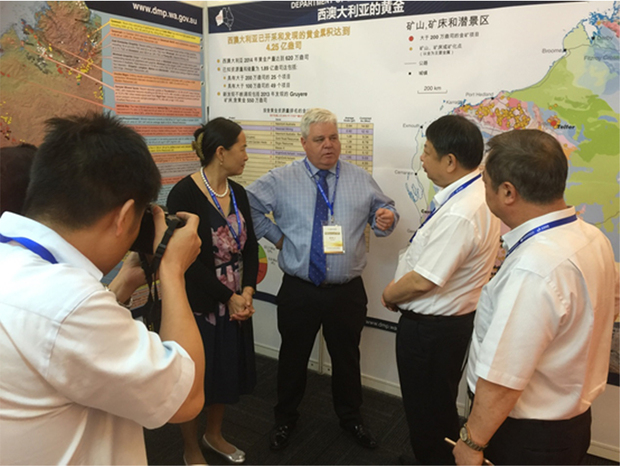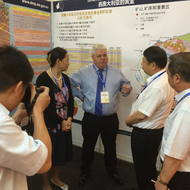Director General ‘incredibly positive’ about meetings during trip to Beiljing
| Date: | Thursday, 18 August 2016 |
|---|
A rock star welcome greeted Department of Mines and Petroleum (DMP) Director General Richard Sellers when he stepped up to the podium at a mining investment forum in Beijing late last month.
“It was like being a rock star with all the cameras and smart phones being held over people’s heads to take photos of the slides we were presenting,” Mr Sellers said.

“It would have been a real eye opener for people used to audiences where people politely sit and listen and even frown if someone is chatting.
“If a Chinese audience is keen on what you’re presenting, everyone is pointing and taking photos and there’s a constant murmuring going on.”
Mr Sellers, who travelled to China with DMP Mineral Promotion Manager Gaomai Trench for three days of conferences, forums and meetings, said the country clearly had a growing appetite for Western Australian gold and other mineral resources such as lithium, rare earths, copper, nickel and lead.
The tumultuous reception the Director General received at the Belt and Road Countries Mining Investment Forum on 28 July followed a speech he gave the day before at the opening ceremony of the 2016 China Gold Conference.
“China is the largest gold producer in the world, producing somewhere in the vicinity of 400-450 tonnes of gold annually, but its total consumption is about 950 tonnes, so it needs a lot of gold from other sources,” Mr Sellers said.
“If you regard Western Australia as a country rather than a State, it would be the fourth biggest producer of gold in the world.
“We produce about 200 tonnes of gold a year and we are the biggest gold province in the world, so we’re literally sitting on a treasure chest.
“That was what we put on a slide we used in the presentation: Western Australia – the biggest individual gold province in the world – and it certainly captured the audience’s attention.”
While in Beijing, Mr Sellers attended meetings with private companies and government entities, including the China National Nuclear Corporation, Stone Resources and the China Coal Exploration Bureau.
Underscoring China’s shift away from coal, the bureau meeting discussed a wide range of opportunities presented by Western Australia.
The powerfully resourced coal exploration bureau has diversified its interests since it first invested in Australian coal.
“The bureau was tasked with finding enough energy for China both internally and externally, so they invested in some of the massive coal mines on the East Coast,” Mr Sellers said
“Now their focus has grown much wider and they’re looking at all energy and industrial minerals, particularly gold and lithium.
“We were only meant to be there for about an hour but we ended up having a two-and-a-half hour meeting.”
Mr Sellers said that the members of the bureau were very interested in Western Australia’s lithium deposits.
“China has massive lithium reserves that are mainly lake-based, but we’ve got the spodumene hard rock deposits and that is a highly attractive alternative source,” Mr Sellers said.
“There was also great interest in our rare earth elements, copper, lead, zinc and particularly nickel, because they see it as being at the bottom of its price curve and ready to rise again.”
Mr Sellers said the bureau had obviously done its homework on Western Australia before the meeting, but its members had been surprised by the richness of the State’s copper deposits.
“The bureau really appreciated the opportunity to talk to us about a range of investment issues including due diligence, how to select the right project, and how investment is protected through low sovereign risk,” he said
“This is a big, highly resourced organisation employing about 50,000 people and they will definitely be coming here to look at what Western Australia has to offer.
“At the end of the trip, I felt incredibly positive about every single one of the meetings we went to. There could be some very significant investment flowing into Western Australia as a result.”

